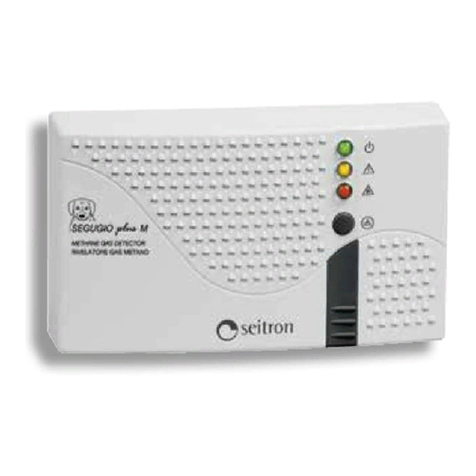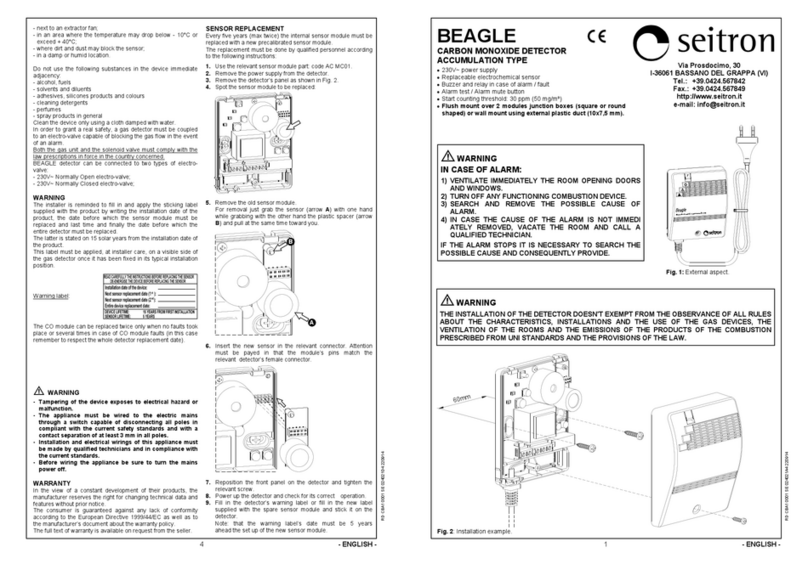
2
DDMSM30001T5 031751 250219
- alcool, benzină
- solvenţi şi diluanţi
- lipici, vopsele sau produse cu silicon
- detergenţi pentru curăţenie
- parfumuri
- spray în general
Pentru a curata dispozitivul folositi NUMAI o carpa
umezita in apa.
Instalaţia de gaze si electrovana ce se conecteaza la Receiver
trebuie să corespundă cerintelor legale în vigoare din ţara interesată
Pentru a verifica eficienţa corectă a senzorului aparatului este
disponibilă o butelie de gaz pentru teste (opţională) care trebuie să
se folosească în conformitate cu indicaţiile care i se anexează.
ATENŢIE: Folosirea oricărei alte metode de probă, cum ar fi
cu bricheta, vapori inflamabili etc. poate duce la concluzii
greşite precum şi la avarierea ireversibilă a însuşi
senzorului.
ATENŢIONĂRI
Se aminteşte instalatorului să completeze şi să pună eticheta
adezivă furnizată împreună cu produsul indicând data instalării
aparatului, data până la care să se înlocuiască pentru prima oară
modulul senzorului, data până la care să se înlocuiască a doua
oară şi ultima data modulul senzorului şi in sfârşit data până la
care să se înlocuiască întregul aparat. Aceasta din urmă
corespunde cu 15 ani calendaristici de la data instalării aparatului.
Eticheta trebuie pusă prin grija instalatorului pe o parte a
aparatului vizibilă în poziţia tipică de instalare.
Etichetă atenţionări:
Senzorul poate fi înlocuit maxim de două ori şi numai de către
persoane calificate.
Pentru a instala dispozitivul efectuaţi următoarele
operaţiuni:
1. ACCESAŢI PĂRŢILE INTERNE
Pentru a accesa părţile interne ale detectorului de gaze,
deşurubaţi şurubul care se află sub lamela de strângere dispus
pe partea din faţă (Fig. 2).
2. Fixaţi baza detectorului de gaze pe o cutie de joncţiune cu 2
module prin intermediul celor două locaşuri pentru şuruburi cu
interax de 60 mm având grijă să faceţi să treacă cablurile în
fantă aşa cum se arată în Fig. 3.
ATENŢIE:
Instalarea dispozitivului este prevăzută pentru montarea în cutii de
joncţiune cu încastrare (sau pe perete) standard cu două module şi
branşări cu cablurile subterane existente şi provenind de la
instalaţia electrică fixă.
Siguranţa şi funcţionalitatea aparatului sunt garantate numai cu o
branşare care să exploateze trecerea pentru cabluri prevăzută la
baza din material plastic.
- ROMANA -
3. LEGATURILE ELECTRICE
Urmaţi schema de conectare redată în Fig. 5.
Bornele L şi N alimentează detectorul de gaze şi trebuie
conectate la tensiunea de reţea 230V ~ cu nulul pe borna N.
4. ÎNCHIDEŢI DISPOZITIVUL
Introduceţi capacul în locaşul special, înşurubaţi respectivul
şurub şi reintroduceţi lamela ce acopera şurubul.
5. ALIMENTAŢI DETECTORUL DE GAZE
6. CONFIGURAREA SISTEMULUI RADIO
Activati modalitatea de "Auto-Asociere" apasand de 2 ori
rapid consecutiv (dublu- click) tasta ‘A’, vizibila in Fig. 4.
In modalitatea "test" detectorul de gaztrasmite continuula
receiver o comanda de “alarma” urmata de o comanda de “nicio
alarma" la doua secunde; de fiecare data cand detectorul de
gaz transmite o comanda radio, led-ul rosu vizibil in ‘B’ din Fig. 4
va lumina o data scurt. Demaraţi procedura de "învăţare
automată" pe receptor în scopul de a determina memorarea de
către receptor a adresei detectorului de gaze transmiţător.
Modalitatea Test se finalizeaza apasand o data tasta "A"
vizibila in Fig. 4 sau se termina automat dupa circa 17 minuti.
Când se dispune detectorul de gaze în zona dorită, asiguraţi-vă că
cele două dispozitive mai comunică încă în mod corect. Calitatea
semnalului se poate monitoriza pe receptor, vedeti respectiva
documentaţie pentru mai multe informaţii.
ATENŢIE!
Dacă intensitatea semnalului primit de receptor nu e
acceptabilă încercaţi să schimbaţi poziţia receptorului sau
transmiţătorului sau eventual evaluaţi posibilitatea de a
instala un dispozitiv de repetare (DA0411) care dublează
fluxul comenzilor radio. Nu uitaţi că atât transmiţătorul cât
şi receptorul trebuie să fie montate departe de obiecte
metalice sau pereţi consolidaţi metalic care ar putea slăbi
semnalele radio.
7. COMPLETAŢI ŞI PUNEŢI ETICHETA DE ATENŢIONĂRI
(A se vedea paragraful "ATENŢIONĂRI").
SCHEME DE CONECTARE
Fig. 5: Schema legaturilor pentru conectarea detectorului de
gaze la reţeaua electrică.
Fig. 2
ÎNLOCUIREA SENZORULUI
La fiecare cinci ani (ptr max.de două ori) e necesar să se
înlocuiască placuta-modul cu senzor din interiorul detectorului cu
un modul nou cu senzor precalibrat. Operaţia de înlocuire trebuie
efectuată de personal calificat conform următoarelor indicaţii:
1. Folosiţi modulul-senzor de schimb, special aferent:
SEGUGIO L WIRELESS: AC MG01
SEGUGIO M WIRELESS: AC MM01
2. Întrerupeţi alimentarea detectorului.
3. Îndepărtaţi capacul cum se arată în Fig. 2.
4. Identificaţi modulul senzor de înlocuit.
5. Scoateţi / extrageti vechiul modul senzor.
Pentru a-l scoate e suficient să luaţi modulul cu două degete
de marginile placutei senzorului (cum evidenţiază săgeţile) şi
să trageţi orizontal spre sine.
6. Luaţi noul modul senzor şi introduceţi-l în conectorul
special, având grijă să coincidă conectorul modulului cu
cel al detectorului.
ATENŢIE: Componentele Modulului Senzor
trebuie sa fie orientate catre dreapta.
7. Introduceţi capacul în lacaşul special şi înşurubaţi respectivul
şurub.
8. Alimentaţi detectorul şi verificaţi funcţionarea.
9. Completaţi eticheta de atenţionări anterior pusă pe detector
sau aplicaţi şi completaţi noua etichetă de avertizări
furnizată în dotarea modulului senzor de schimb.
Nu uitati că data corespunde cu 5 ani calendaristici de la
data punerii în funcţiune a noului modul senzor.
Importator / Reprezentant Unic si
Centru asistenta - BALCANI
GazPro Equipments srl
str.Pastorului nr.4sector 2
Bucuresti, Romania
Tel.: 0722-745312; 0745040429
E-mail: gazproequipments@gmail.com
Web: https://www.gazproequipments.ro
CITIŢI CU ATENŢIE INSTRUCŢIUNILE ÎNAINTE DE A ÎNLOCUI
SENZORUL. ÎNTRERUPEŢI ALIMENTAREA ELECTRICA ÎNAINTE DE A
ÎNLOCUI SENZORUL.
Data instalării aparatului: __________________
Data viitoarei înlocuiri (1^) a senzorului: __________________
Data viitoarei înlocuiri (2^) a senzorului: __________________
Data înlocuirii aparatului: __________________
DURATA DE VIATA A APARATULUI: 15 ANI DE LA PRIMA
INSTALARE DURATA DE VIATA A SENZORULUI: 5 ANI
Fig. 3
Fig. 4
A
B
























